You double-check your work. You’ve written every word yourself. And yet, you hesitate before hitting “submit.” Because now, it’s not just about grammar or flow.
It’s also about whether an AI detector will believe you wrote it.
This is the new reality in 2025. AI detection tools like Cramly are becoming gatekeepers, deciding if your writing is “human enough.” But here’s the problem: what if it gets it wrong?
False flags. Unclear results. And a whole lot of stress for people just trying to do honest work.
If you’re wondering whether Cramly is helpful, harmful, or somewhere in between, you’re not alone.
In this review, we’ll discuss it clearly: what it is, how it works, and what you really need to know before you trust it with your words.
Read on!
What is Cramly’s AI Detector?
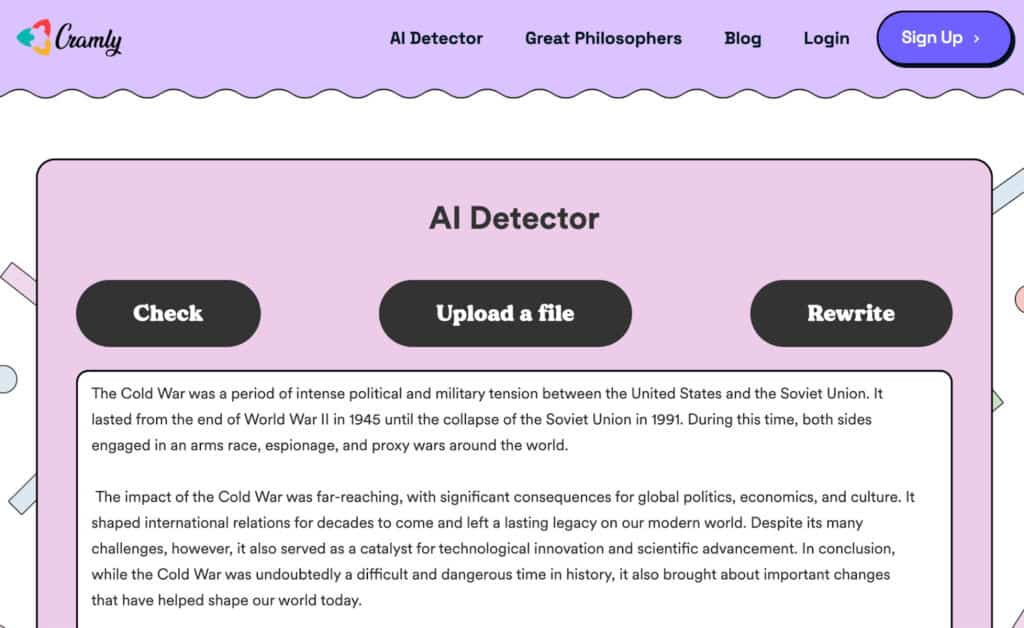
[Alt text: Image showing Cramly’s AI detector page. Source.]
If you ask someone what is Cramly AI, they’ll tell you it helps people write faster. Essays, outlines, summaries, you name it, and it will do it.
But one of its quieter features is its AI Detector, a tool that claims to tell if something was written by a human or an AI.
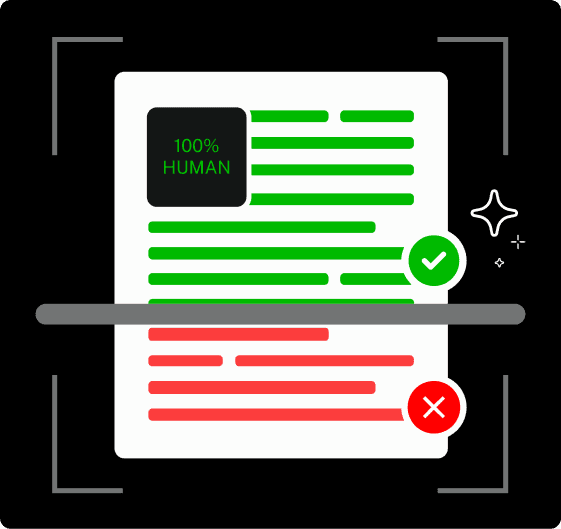
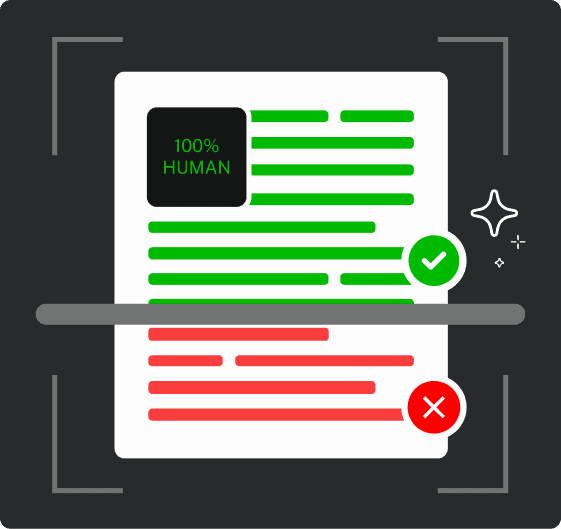
Never Worry About AI Detecting Your Texts Again. Undetectable AI Can Help You:
- Make your AI assisted writing appear human-like.
- Bypass all major AI detection tools with just one click.
- Use AI safely and confidently in school and work.
Sounds useful, especially now that AI-generated content is everywhere. But what exactly is this detector, and what can it actually do?
Simply put, Cramly’s AI Detector is a basic checker. You paste in some text, and it tries to guess who (or what) wrote it.
It doesn’t offer deep explanations or try to blindside you with numerous fancy buttons. Instead, it keeps things plain and simple.
For teachers and students, it can act like a second opinion. For writers, it’s a way to make sure their work doesn’t accidentally raise red flags.
That said, it’s not a high-tech lie detector. The results can be hit or miss, and it’s not always clear how it decides what’s “human.”
But it’s simple, fast, and built into a platform that many people are already using.
So while it won’t solve every problem around AI content, it’s trying to be part of the solution, even if it’s still finding its footing.
How It Works
Cramly AI Detector scans your work for AI clues.
When you paste your text into the tool, it doesn’t just look at the words one by one. Instead, it uses artificial intelligence to carefully analyze the way the content is written.
It identifies AI-written content by looking for patterns that might hint that a human didn’t write it.
One of the things Cramly does is check if parts of your text match other sources already out there.
If it finds whole phrases or sentences that look very similar to something else online or in its database, it raises a flag.
This doesn’t automatically mean someone cheated, but it’s a signal that those parts might not be original.
The tool is also smart enough to notice when AI-generated text has been tweaked to seem more human. (Not always, though!)
For example, if someone took AI content and changed a few words here and there, Cramly can sometimes still catch it.
That said, Cramly’s detector isn’t perfect. Sometimes it might mistake well-written human text for AI or miss cleverly rewritten AI content.
Accuracy and Reliability
Cramly’s AI Detector tries to figure out if a piece of writing was done by a human or a computer.
It’s pretty straightforward to use, but when it comes to accuracy, it’s a mixed bag.
It does a good job spotting text that’s fully AI-generated as it catches most of those without much trouble. But where it gets tricky is with human writing.
Sometimes, it mistakenly thinks something written by a real person is actually made by AI. That can be frustrating, especially for those who need to be sure about what’s genuine.
Another problem is when you rewrite or humanize AI content to add a personal touch. In those cases, Cramly’s detector might miss it entirely.
This shows how tough it is for tools like this to keep up with smarter AI writing that doesn’t sound robotic.
Also, Cramly AI doesn’t have extra features like checking sentence by sentence or connecting with other software, which some users might want for deeper checks.
So, while Cramly can give you a quick look at whether something might be AI-written, it’s not perfect.
If you really need to know for sure, it’s best to use it alongside other tools or methods.
Testing Cramly AI Detector: Our Method
When I first heard about the Cramly AI Detector, I was curious but also skeptical. Like most people, I had questions.
Does it actually work?
Is it reliable?
The only way to find out was to test it myself. So, I decided to run a small experiment.
First, I pasted the intro to this blog (which is obviously written by me). It was written in my own voice, with my own thoughts. Safe to say, it was completely natural writing.
Then, I asked ChatGPT to write an intro on the same topic so I’d have a clear example of AI-generated content to compare it with.
Both pieces were roughly the same length and covered similar points, though the tone and style obviously differed.
Once I had both versions, I ran them through Cramly’s AI Detector. I wanted to see if Cramly could distinguish between something written by me and by AI.
The results gave me a clearer picture of what the tool is good at (and where it struggles).
Results with Entirely Human-Written Content
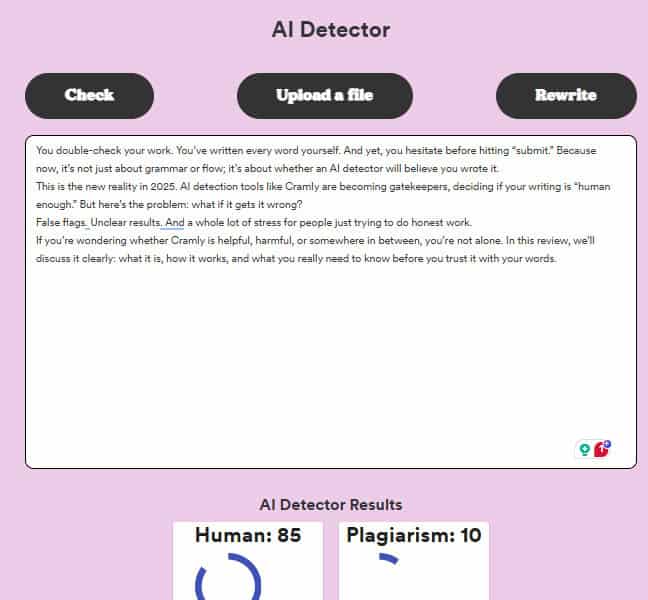
[Alt text: Image showing Cramly’s AI detection results.]
Results with AI-Generated Content
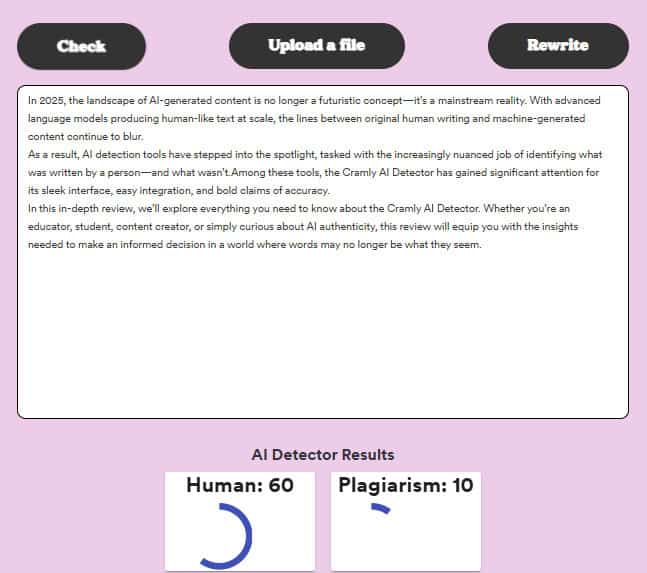
[Alt text: Image showing Cramly’s AI detection results.]
Even if you’re not one to experiment with AI often, it’s clear how different these two writing pieces are.
The second one, although with a complete robotic tone, is only flagged as 10% plagiarized.
So, I wouldn’t say Cramly AI detector is a tool I’d count on a rainy day!
Pros and Cons
We’ve reached this far, so it wouldn’t be fitting to leave out the pros and cons of Cramly AI now.
Let’s take a quick look:
Pros
- Simple and Easy To Use: Cramly doesn’t make you jump through hoops. You paste your text, hit a button, and boom, it gives you feedback. It doesn’t have confusing settings or dropdowns.
- Affordable: Cramly’s pricing is pretty pocket-friendly. There’s a free version, and if you need more features, the paid plan is still cheaper than a lot of the big-name competitors.
- Includes Other Tools: It’s not just an AI detector. Cramly also throws in things like a plagiarism checker and writing tools (like a paraphraser and a multiple-choice solver).
Cons
- Occasional Inaccuracy: Sometimes, it confidently labels a paragraph “AI-generated” when it was clearly written by a human. And other times, it lets actual AI content slide through as “human-written.” This happens especially with writing that sits in the gray zone. That kind of subtlety throws it off.
- No Overall Score: Cramly highlights individual sentences and tells you whether each one seems AI or not, but it doesn’t give a clear final verdict. You’re left piecing together the results yourself. It’s not ideal if you’re in a hurry or need a clear yes or no.
- Not Built for Power Users: If you’re expecting high-level features like PDF upload, API access, multi-language support, or deep analysis, this tool isn’t quite there yet. It’s built for quick checks, not complex workflows.
Cramly AI Detector does what it says on the label… well, for the most part at least.
It’s fast, simple, and does a decent job catching AI-generated content that’s a little too smooth for its own good.
But when it comes to subtle, human-sounding AI or genuine writing with a unique tone, its accuracy starts to wobble.
If you’re using it as a general guide or a second opinion, it’s helpful. Just don’t rely on it as the final judge.
Cramly vs Other AI Detectors
Of course, Cramly isn’t the only fish in the sea. There are plenty of (and might I add, better) AI content detectors out there.
Let’s compare Cramly with a few others:
Undetectable AI
Undetectable AI is good at detecting AI, and it’s built to understand the nuances of both human and machine writing.
It’s surprisingly accurate with subtle, mixed-content text, and it does a great job avoiding false positives.
I experimented with Undetectable AI the same way I did with Cramly. I asked ChatGPT 4o to generate a 100-word intro for this Cramly review blog.
Here’s what it generated:
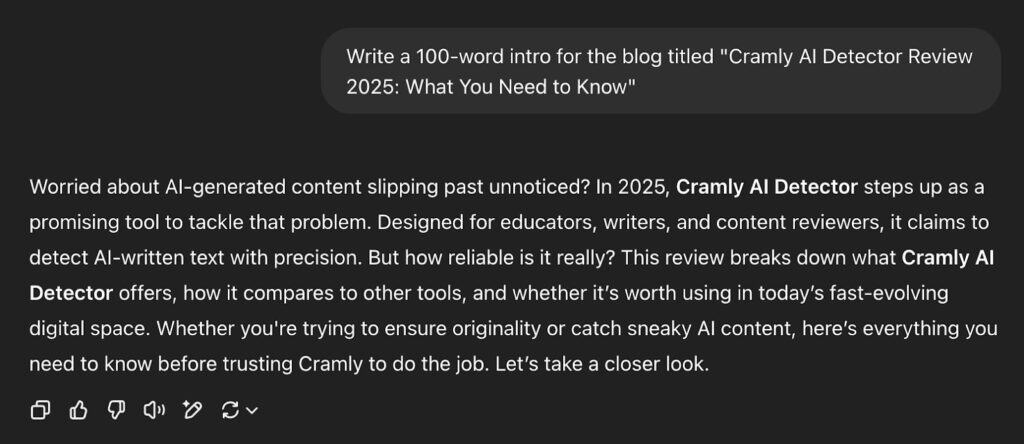
[Alt text: Image showing ChatGPT-generated response.]
Now, let’s test this AI generated content using Undetectable AI:

[Alt text: Image showing Undetectable’s AI detector results.]
You can see in the above image how cleverly it detected the AI-generated content. It flagged the whole intro as AI except for 1 sentence that feels human. Pretty accurate, right?
You can also try it here for free.
Copyleaks
Copyleaks offers more detailed reports and an overall AI probability score. It’s also more transparent about how it evaluates content. However, it can be a bit slow and sometimes overconfident in its results.
Originality.ai
Originality.ai does a solid job of detecting AI-written articles and even supports team collaboration. But its interface can feel a bit clunky for casual users. It’s better suited for people managing large volumes of content.
Who Should (and Shouldn’t) Use It
Cramly’s AI Detector is a safe choice, even if it’s not always reliable. It can give you a subtle idea about whether a text is human-written or not.
But if you want irrefutable, accurate results, it’s a no-go.
This means teachers should specifically not count on it when assessing students’ assignments. The tool may flag inaccurate content, leading the student to lose important marks.
However, if you’re a content marketer, you can run your content through it to check for AI writing.
Just remember not to trust it 100%.
Final Verdict: Is Cramly AI Detector Worth It?
Cramly AI Detector is a decent tool if your expectations are realistic.
It’s quick and easy to use for casual users or students doing a basic scan.
But the trade-off is accuracy. It tends to jump to conclusions with certain writing styles. It also doesn’t give you much context behind its verdicts, which can leave you guessing.
So, is it “worth it”? That really depends on how much you’re relying on it. As a first glance tool? Sure. As your only source of truth? Probably not.
You’d be better off with something more accurate, like Undetectable AI Detector for more serious or sensitive use.
